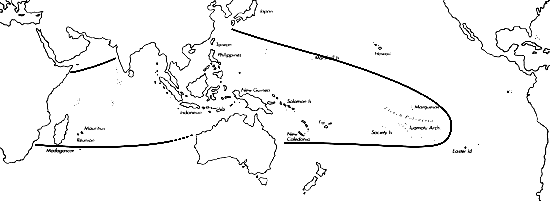Range: Mozambique to Somalia, to Marshall Is. and French Polynesia.
Description: Moderately large to large, moderately solid. Last whorl ovate to cylindrical; outline convex or almost straight and parallel-sided centrally; left side straight to distinctly concave at basal third. Aperture wider at base than near shoulder. Shoulder subangulate. Spire low, outline slightly concave or straight. Larval shell of about 4 whorls, maximum diameter 0.8-0.9 mm. First 4-7 postnuclear whorls tuberculate. Teleoconch sutural ramps usually somewhat concave, with 1 increasing to 4-9 spiral grooves; latest whorls usually with additional spiral striae, first 3 whorls with a prominent subsutural ridge. Last whorl with a few weak, variably spaced spiral ribsat base.
| Shell Morphometry | ||
|---|---|---|
| L | 50-95 mm | |
| RW | 0.16-0.25 g/mm | |
| (L 50-80 mm) | ||
| RD | 0.50-0.57 | |
| PMD | 0.61-0.72 | |
| RSH | 0.09-0.11 | |
Ground colour bluish grey, suffused with blue or pink. Last whorl with confluent reddish brown flames and blotches often fusing into an interrupted spiral band on each side of centre. Spiral rows of alternating brown and white dots and dashes from base to shoulder. Larval whorls red, with a brown sutural line. Early postnuclear sutural ramps pink to violet, with regularly spaced brown dots at outer margins, sometimes also at inner margins; usually only first ramp dotted at both margins. Late sutural ramps sparsely maculated with dark reddish brown flecks and radial blotches. Aperture bluish white, translucent toward outer lip.
Periostracum yellowish brown, rather thin, translucent to opaque, with 4-7 widely spaced spiral rows of tufts on last whorl including shoulder; Cernohorsky (1964) reports a smooth periostracum from Fiji.
Dorsum of foot white, heavily mottled with brown radial streaks and blotches, larger and concentrated marginally. Sole of foot white to beige, sparsely mottled with brown flecks that are interspersed by darker longtudinal stripes. Rostrum beige, sparsely mottled with light brown; orifice surrounded by a dense cluster of white cirri. Tentacles white, tipped with brown and with sparse light brown mottling at base. Siphon grey, with transverse rows of brown bars and streaks, confluent at base; tip dark grey but with a lighter distal edge (Marshall Is.) (Pearson, unpubl. observ.). Reports of Quoy and Gaimard (1824) correspond with this description (Pl. 81, Fourth row, left).
Radular teeth with 2 opposite adapical barbs; serration of 15-25 denticles extends from first barb 1/3 the length of the shaft; basal spur obsolete or absent (Bergh, 1895; Shaw, 1915; Peile, 1939; James, 1980; Kohn, unpubl. observ.).
Habitat and Habits: Intertidal to about 10 m; usually reported from coral reefs, in Mozambique also in intertidal habitats of the mainland coast; in sand patches beneath rocks and coral boulders, on coral rubble among sea-weed, and on rocky flats exposed to wave action (Meese, 1969; Huish, 1978; Estival, 1982; Richards, pers. comm., 1989; Grosch, pers. comm., 1989). C. tulipa feeds on fishes and molluscs. Fishes are either engulfed after stinging them or without stinging them first. The venom is highly toxic to fishes and small mammals (Endean & Rudkin, 1965). In Seychelles, R. C. Wood observed females ovipositing below loose corals in depressions near the reef edge (Kohn 1961b). Pearson (unpubl. observ.) observed C. tulipa mating and ovipositing in the aquarium; capsules are axially elongate and have a slightly corrugated surface.
Discussion: C. tulipa is easily distinguished from C. geographus, C. eldredi, and C. fragilissirnus by its nontuberculate late postnuclear whorls and pale blue ground colour. For comparison with C. obscurus, see the Discussion of that species. C. borbonicus is a juvenile shell.

C. tulipa range map
This section contains verbatim reproductions of the accounts of 316 species of Conus from the Indo-Pacific region, from Manual of the Living Conidae, by Röckel, Korn and Kohn (1995). They are reproduced with the kind permission of the present publisher, Conchbooks.
All plates and figures referred to in the text are also in Röckel, Korn & Kohn, 1995. Manual of the Living Conidae Vol. 1: Indo-Pacific Region.
The range maps have been modified so that each species account has it own map, rather than one map that showed the ranges of several species in the original work. This was necessary because each species account is on a separate page on the website and not confined to the order of accounts in the book.